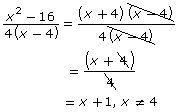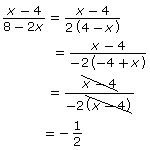Lesson 1
| Site: | MoodleHUB.ca 🍁 |
| Course: | Math 30-2 SS |
| Book: | Lesson 1 |
| Printed by: | Guest user |
| Date: | Wednesday, 24 December 2025, 8:22 AM |
Description
Created by IMSreader
1. Lesson 1
Module 5: Rational Expressions
Lesson 1: Simplifying Rational Expressions
Focus

Hemera/Thinkstock
Simulators are practical training tools that mimic actual conditions for people to use before they attempt the real item. Students must control equipment and instrumentation that is similar to what is found in real items.
Simulators provide a safe environment for learning how to navigate different scenarios that may be encountered in real life.
In previous math courses you worked with rational numbers. The strategies you learned to generate equivalent fractions and simplify fractions will help you to do the same processes with rational expressions. Your previous experience with rational numbers can be thought of as the training for, or simulation of, the work you will do with rational expressions in this lesson and module.
Lesson Outcomes
At the end of this lesson, you will be able to
- compare the strategies for writing equivalent forms of rational expressions to the strategies for writing equivalent forms of rational numbers
- determine the non-permissible values for a rational expression and explain why such values are non-permissible
- determine equivalent rational expressions to given rational expressions and explain why the non-permissible values of both are the same
- simplify a rational expression and identify, correct, and explain errors in the simplification of a rational expression
Lesson Questions
You will investigate the following questions:
- How is the process of simplifying rational expressions similar to the process of simplifying rational numbers?
- Why are some values not permitted in a rational expression?
Assessment
Your assessment may be based on a combination of the following tasks:
- completion of the Lesson 1 Assignment (Download the Lesson 1 Assignment and save it in your course folder now.)
- course folder submissions from Try This and Share activities
- additions to Glossary Terms
- work under Project Connection
Self-Check activities are for your own use. You can compare your answers to suggested answers to see if you are on track. If you are having difficulty with concepts or calculations, contact your teacher.
Remember that these questions and activities provide you with the practice and feedback that you need to successfully complete this course. You should complete all the questions and place the answers in your course folder. Your teacher may wish to view the work to check on your progress and to see if you need help.
Time
Each lesson in Mathematics 30-2 EveryWare is designed to be completed in approximately two hours. You may find that you require more or less time to complete individual lessons. It is important that you progress at your own pace, based on your individual learning requirements.
This time estimation does not include time required to complete Going Beyond activities or the Module Project.
1.1. Launch
Module 5: Rational Expressions
Launch
Do you have the background knowledge and skills you need to complete this lesson successfully? Launch will help you find out.
Before beginning this lesson, you should be able to
- define rational numbers
- write equivalent fractions
- determine the prime factorization of a number
- use prime factorization to simplify fractions
- factor polynomials
1.2. Are You Ready?
Module 5: Rational Expressions
Are You Ready?
Complete these questions. If you experience difficulty and need help, visit Refresher or contact your teacher.
- What is a rational number? Answer
- Complete each statement so that the fractions are equivalent.
- Determine the prime factorization of each expression.
- 24
- 60
- 30x2y
- Use prime factorization to simplify the following fractions.
- Factor the following polynomials.
- 2xy − 4y
- x2 − 36
- 2a2 − 50
If you answered the Are You Ready? questions without problems, move to Discover.
If you found the Are You Ready? questions difficult, complete Refresher.
1.3. Refresher
Module 5: Rational Expressions
Refresher
Use Rational Numbers to review the definition of rational numbers.
Review examples of writing and simplifying fractions in Equivalent Fractions.
Open the Greatest Common Factor (GCF) applet to review how to use prime factorization to find the greatest common factor.
There are two strategies for factoring binomials: taking a GCF and a difference of squares. Watch the video titled Factoring Binomials Review to see binomial factoring strategies.
Go back to the Are You Ready? section and try the questions again. If you are still having difficulty, contact your teacher.
1.4. Discover
Module 5: Rational Expressions
Discover

iStockphoto/Thinkstock
Sometimes numbers have a somewhat magical quality. But rest assured, there are mathematical concepts behind that magic. Try the puzzle in the Try This activity to see if you can figure out the math behind the magic.
Try This 1
Follow the steps in Table 1.
| TABLE 1 | |
| Step | Instruction |
| 1 | Pick any number. |
| 2 | Square the number. |
| 3 | Subtract 4 from the result. |
| 4 | Divide the result by 2 more than the original number. |
- How does the final result compare to the original number?
- Repeat the procedure three times with a different starting number each time. What do you notice?
- Copy Table 1. Then add a third column, as shown, called “Expression.” Write an expression for each step in the table, beginning with the expression x.
TABLE 2 Step Instruction Expression 1 Pick any number. x 2 Square the number. 3 Subtract 4 from the result. 4 Divide the result by 2 more than the original number. - Based on your answers to questions 1 and 2, what is another expression that could be used to represent the final result?
- There is one starting number that does not yield a similar result to the other ones. Can you determine this number?
Save your responses in your course folder. You will need to retrieve these results later in the lesson in order to check your work and to share what you have learned with a partner.
1.5. Explore
Module 5: Rational Expressions
Explore

Photos.com/Thinkstock
Do you have a favourite board game? Perhaps you like classic games, such as Monopoly, The Game of Life, or Snakes and Ladders. Two important principles of game design are realism and simplicity. Part of what makes these games enjoyable is the fact that they simulate real-world contexts. In the examples provided here, one is a real-estate trading game, another takes you through the milestones of life, and the third simulates life with ladders rewarding good acts and snakes penalizing bad.
In this lesson you will study rational expressions. Just like a game designer creates games based on reality, you will learn how to write algebraic expressions that are equivalent to other expressions. As well, just as games are simplified versions of the real thing, you will learn to simplify rational expressions.
Recall that the definition of a rational number is a real number that can be expressed in the form ![]() where a and b are integers and b ≠ 0.
where a and b are integers and b ≠ 0.
A rational expression has a similar definition. A rational expression can be expressed in the form of ![]() where a and b are polynomials and b ≠ 0.
where a and b are polynomials and b ≠ 0.
Now that you have the definition of a rational expression, work through Identifying Rational Expressions to help you identify a rational expression.
Self-Check 1
Which of the following expressions are rational? Explain.



- 3x
1.6. Explore 2
Module 5: Rational Expressions
Retrieve your work from Try This 1. In that activity you picked a number and applied a series of mathematical operations to the number. You should have obtained the following rational expression to describe the result:
![]()
You may have noticed that the result is always 2 less than the original number. For example, if you started with the number 19, your final result was 17. You may have also determined that there was one number that does not follow this pattern.
Share 1
Confirm that x = −2 does not yield the same result as any other value of x. With a partner, discuss why x = −2 does not follow the same pattern.
![]() If required, save a record of your discussion in your course folder.
If required, save a record of your discussion in your course folder.
1.7. Explore 3
Module 5: Rational Expressions
A rational expression is not defined when its denominator is 0. Therefore, any value of the variable that would result in a denominator of 0 is called a non-permissible value.
Try This 2
For each of the rational expressions in the table, determine the non-permissible value(s).
| Rational Expression | Non-Permissible Value(s) of x |
![]() Save your responses in your course folder.
Save your responses in your course folder.
1.8. Explore 4
Module 5: Rational Expressions

In Try This 2, you found the non-permissible values for a variety of expressions by letting the denominator equal 0 and solving for the variable. These non-permissible values are also called restrictions.
Review “Example 3” on pages 219 and 220 of your textbook to see how you can determine non-permissible values for rational expressions that are similar to the expressions in Try This 2. As you read, think about the following questions:
- How are the equations to find non-permissible values created?
- Why is it not necessary to determine when numerators are equal to 0?
- How does factoring the denominator make it easier to identify non-permissible values?
Look back at your answers to Try This 2. After reading through “Example 3,” are there any answers you would change? Why?
Self-Check 2
- Determine the non-permissible values.
![]()
- Complete questions 10.b. and 10.d. on page 223 of your textbook. Answers
1.9. Explore 5
Module 5: Rational Expressions
What happens to a number if you multiply it by 1? If you said that the number remains unchanged, you are absolutely correct. This property of 1 is critical in determining equivalent expressions in mathematics.
Try This 3
- Multiply or divide the following expressions.
- Verify that the end result for each of the calculations in question 1 is equivalent. You may want to do this by using your calculator to check that the decimal representation of the original number is identical to that of the final number.
- To what number is
 ,
,  and
and  equivalent?
equivalent? - Compare the following two expressions:
 and
and 
- Determine the non-permissible values of the variable in each expression.
- Evaluate each expression for t = 3.
- Are the expressions equivalent? How do you know?
![]() Save your responses in your course folder.
Save your responses in your course folder.
Share 2
Try This 3 question 3 shows an example of the property of 1. Use this property to create equivalent fractions. With a partner or in a group, answer the following questions.
- Can you represent the number 1 using a polynomial?
- Can each of you provide two examples that represent the number 1 using polynomials?
![]() If required, place a summary of your discussion in your course folder.
If required, place a summary of your discussion in your course folder.
1.10. Explore 6
Module 5: Rational Expressions
In Try This 3, you may have noticed that multiplying a rational expression like ![]() by
by ![]() produces an equivalent rational expression,
produces an equivalent rational expression, ![]() . Multiplying a rational expression by a fraction equivalent to 1 will always create an equivalent expression. However, by multiplying by a variable, you may introduce new non-permissible values.
. Multiplying a rational expression by a fraction equivalent to 1 will always create an equivalent expression. However, by multiplying by a variable, you may introduce new non-permissible values.
How did you know the two expressions were equivalent? Because ![]() Therefore, by the property of 1, the expressions are equivalent for t ≠ 0, −2.
Therefore, by the property of 1, the expressions are equivalent for t ≠ 0, −2.
Read “Example 2” on pages 218 and 219 of your textbook for an explanation of how to generate equivalent expressions. As you follow the process that takes a rational expression to an equivalent expression, consider the following: How could you take the equivalent expression and convert the expression back to the original rational expression?
![]() Record your ideas in your course folder. You will look at this process again later in the lesson.
Record your ideas in your course folder. You will look at this process again later in the lesson.
Self-Check 3
Complete questions 3 and 9 on page 223 of your textbook. Answers
1.11. Explore 7
Module 5: Rational Expressions
To simplify a rational expression means to write an equivalent expression where the greatest common factor between the numerator and the denominator is 1. Such an expression is described as being in simplified form or reduced to lowest terms.
The following example shows how you can simplify a rational number by using the method of prime factorization. Pay careful attention to the steps of this example. You will apply these steps to rational expressions in Try This 4 later in this lesson.
Example
- Simplify
 by using prime factorization.
by using prime factorization. - Verify that the simplified form is equivalent to the original rational number.
Solution

Use prime factorization to write out all the factors of the numerator and denominator. 
The expression can be written as the product of three fractions. 
Since the first two fractions are equal to 1, the expression can be simplified. 
Using the property of 1, the expression is again simplified. - According to the property of 1, where any number multiplied by 1 is equal to itself,

You can verify this by putting each side into your calculator, and the answer should be the same.
In Try This 1, you found that by applying a series of mathematical operations to a number, you end up with a number that is 2 less than the original number. The following statement summarizes this observation.
![]()
The expression ![]() is equivalent to the expression x − 2 for all values of x, except when x = −2.
is equivalent to the expression x − 2 for all values of x, except when x = −2.
In Try This 4, you will use the same principles demonstrated in the previous example to verify the result.
Try This 4
-
Consider the rational expression
 Show that this expression simplifies to x − 2.
Show that this expression simplifies to x − 2. 
- Simplify the rational expression
 State any non-permissible values.
State any non-permissible values.
![]() Save your responses in your course folder.
Save your responses in your course folder.
Share 3
In a group or with a partner, answer the following questions.
- What are some key differences between simplifying rational numbers and simplifying rational expressions?
- Why is it necessary to include the non-permissible value(s) with the simplified form even though this form may not have a denominator?
- Based on your answer to question 2, when should you identify non-permissible values?
![]() If required, save a record of your discussion in your course folder.
If required, save a record of your discussion in your course folder.
Use these hints to solve the expression:
- State any non-permissible values.
- Factor the numerator and denominator, as necessary.
- Use the property of 1 to eliminate factors that are common to both the numerator and the denominator.
- Write the simplified expression along with the non-permissible value.
1.12. Explore 8
Module 5: Rational Expressions
Turn to “Example 3” on page 228 of your textbook to see how you can simplify a rational expression consisting of two expressions. As you work through the solution, consider these questions:
- What methods are used to factor the numerator and denominator?
- How are the examples of non-permissible values determined?
Click on “Simplifying Rational Expressions Introduction” to watch an example on how to simplify a rational expression. How do the steps used in this video compare with the steps you used in Try This 4?
Self-Check 4
With a partner, complete the following activity. Each of you will answer a set of math questions. One player will answer the questions in the Player A column. The other person will answer the questions in the Player B column. When you’re both done, compare your answers. Your answers should match in each row. If the answers do not match, then work together to figure out where you went wrong. Remember to state the non-permissible values!
| Player A | Player B |
1.13. Explore 9
Module 5: Rational Expressions
When you encounter a rational expression where both the numerator and denominator must be factored before the expression can be simplified, it is possible that they will share a common factor. You can use this knowledge to factor more easily.
Suppose you are required to simplify the following rational expression:
Step 1: Start by factoring the numerator.
![]()
Step 2: Since the numerator has a binomial factor of (a − 1), there is a chance that the denominator will also have the same factor. If so, you will have the following:

Why did the signs of the terms in the denominator change? ![]()
Step 3: You should check that −12 is the second factor by multiplying −12 and (a − 1). In this case, the product is −12a + 12. Therefore, the correct factors are −12 and (a − 1). Now you can use the property of 1 to simplify the expression.

1.14. Explore 10
Module 5: Rational Expressions
Thus far in the lesson, you have learned how to write equivalent rational expressions and reduce them to lowest terms. In the remainder of the lesson, you will study errors that can occur in the process of simplifying rational expressions. You will do this by analyzing the work of fictional students.
Try This 5
The work of four different students is shown. Each student has made an error in simplifying certain rational expressions.
- Analyze the work of each student.
- Identify and explain the error.
- Show the correct solution.
- Marlee

- Neetu

- Aaron

- Siobhan

![]() Save your responses in your course folder.
Save your responses in your course folder.
Share 4
With a partner, compare your answers to Try This 5. Discuss how the errors you identified can be avoided. In other words, are there strategies that can be applied so that the risk of making mistakes is minimized?
![]() If required, save a record of your discussion in your course folder.
If required, save a record of your discussion in your course folder.
1.16. Connect
Module 5: Rational Expressions
Complete the Lesson 1 Assignment you saved in your course folder at the beginning of this lesson. Show work to support your answers.
![]() Save your responses in your course folder.
Save your responses in your course folder.
Project Connection
In Module 5 Project: Dice Game Competition, you will create and play a dice game. Begin by reading all parts of the Module 5 Project as an overview of what you will be doing to complete the project. Then complete Part 1. You will use an applet to determine equivalent rational expressions.
Going Beyond

Creatas/Thinkstock
Do you remember how to divide numbers by long division? The image shows the long division of 353 by 5. The quotient is 70 with a remainder of 3. Study the image in order to review the process.
Did you know that you can also apply long division to polynomials?
In this lesson you simplified expressions such as ![]() by removing factors common to the numerator and the denominator. Long division is another method you can use to simplify rational expressions.
by removing factors common to the numerator and the denominator. Long division is another method you can use to simplify rational expressions.
Compare the long division of rational numbers, such as the one shown in the image, to the long division of the polynomial shown here:
 |
Then answer the following questions.
- Where do you look for the simplified form of the original rational expression?
- Notice that the remainder is zero. What does that mean? What would it mean if the remainder was not equal to zero?
- Where do you look to find non-permissible values?
- Return to some of the questions you completed in this lesson. Use the method of long division to see if your answers match. Are there rational expressions that are better simplified with the long-division method? Are there expressions that are difficult to simplify with this method?
![]() Save your work in your course folder.
Save your work in your course folder.
1.17. Lesson 1 Summary
Module 5: Rational Expressions
Lesson 1 Summary
You investigated the following questions:
- How is the process of simplifying rational expressions similar to the process of simplifying rational numbers?
- Why are some values not permitted in a rational expression?
You discovered that simplifying rational expressions is similar to simplifying rational numbers. In both cases, you must find factors common to both the numerator and the denominator. It is appropriate to eliminate these common factors according to the property of 1.
The property of 1 states that the multiplication of any number by 1 is equal to itself. Therefore, eliminating factors common to both the numerator and the denominator results in an equivalent, but simplified, expression.
You discovered a significant difference between simplifying rational numbers and simplifying rational expressions. In the case of rational expressions, you must consider non-permissible values. Any value(s) of the variable that would result in a denominator equal to 0 is considered non-permissible.
The process of simplifying is an essential skill that should be part of any math student’s repertoire. Simplifying expressions allows you to simplify calculations, especially those that involve multiple steps. Reducing the size of the numbers and the amount of variables that you must carry from step to step makes subsequent calculations easier and reduces the risk of errors.
In the next two lessons you will confirm this claim as you multiply, divide, add, and subtract rational expressions.




